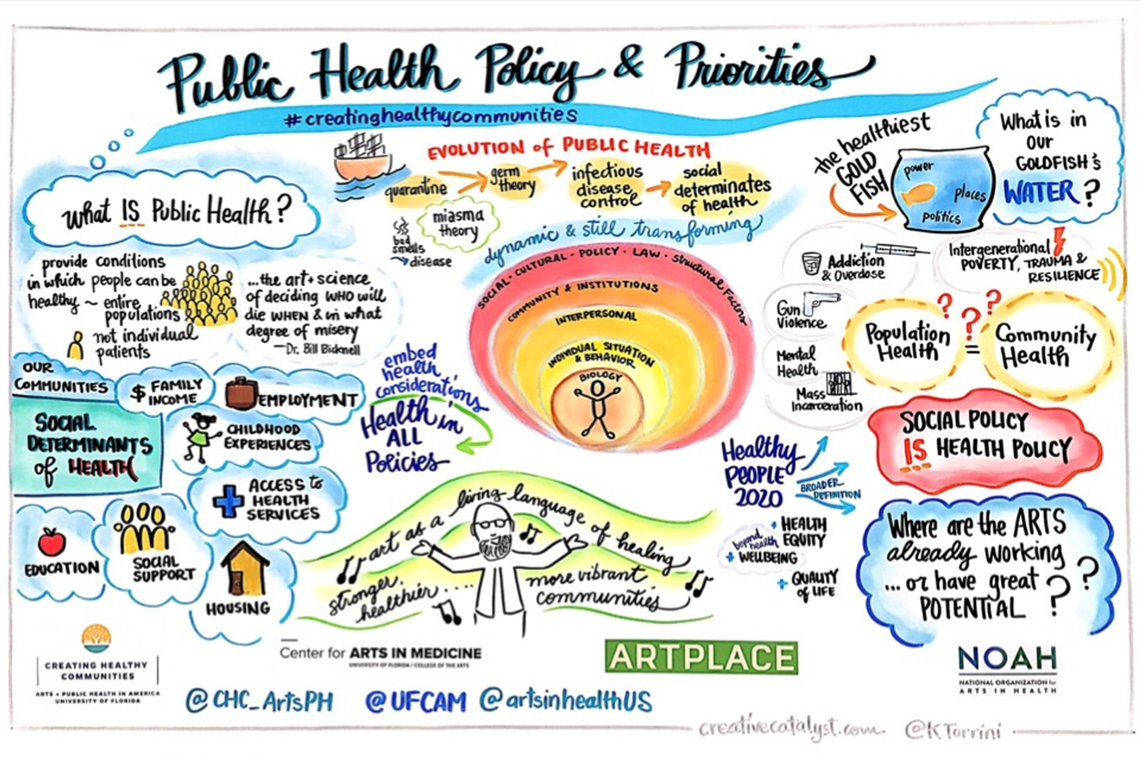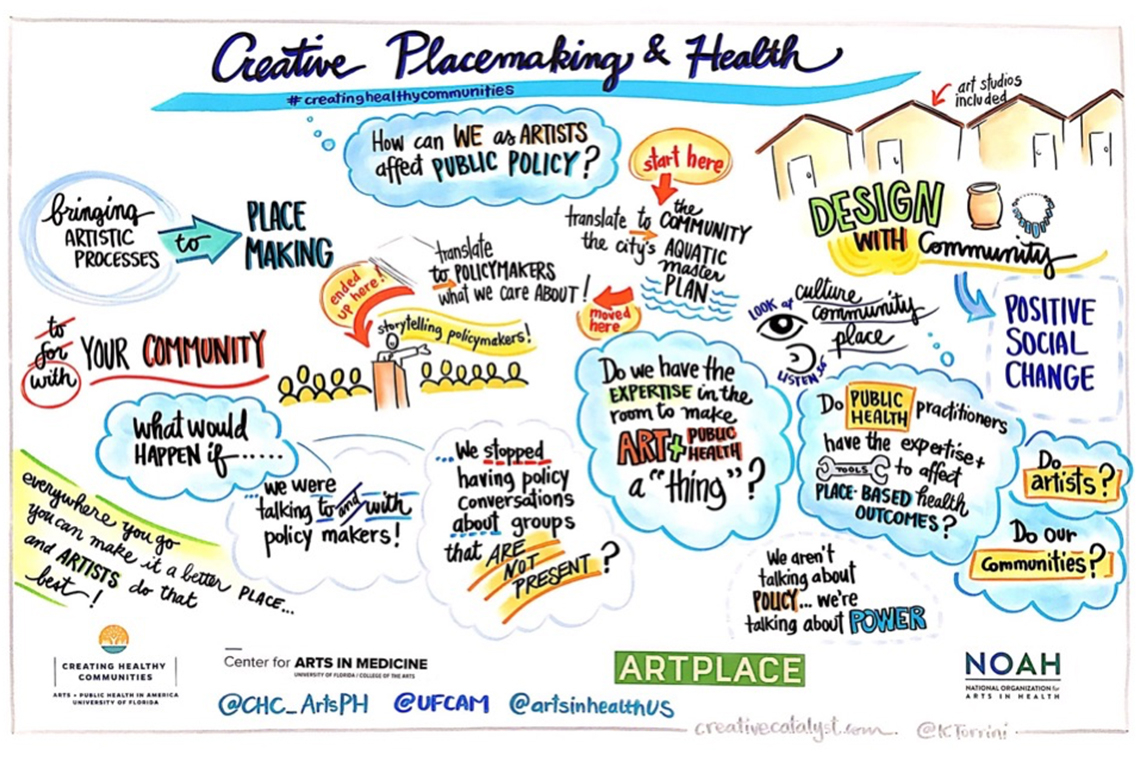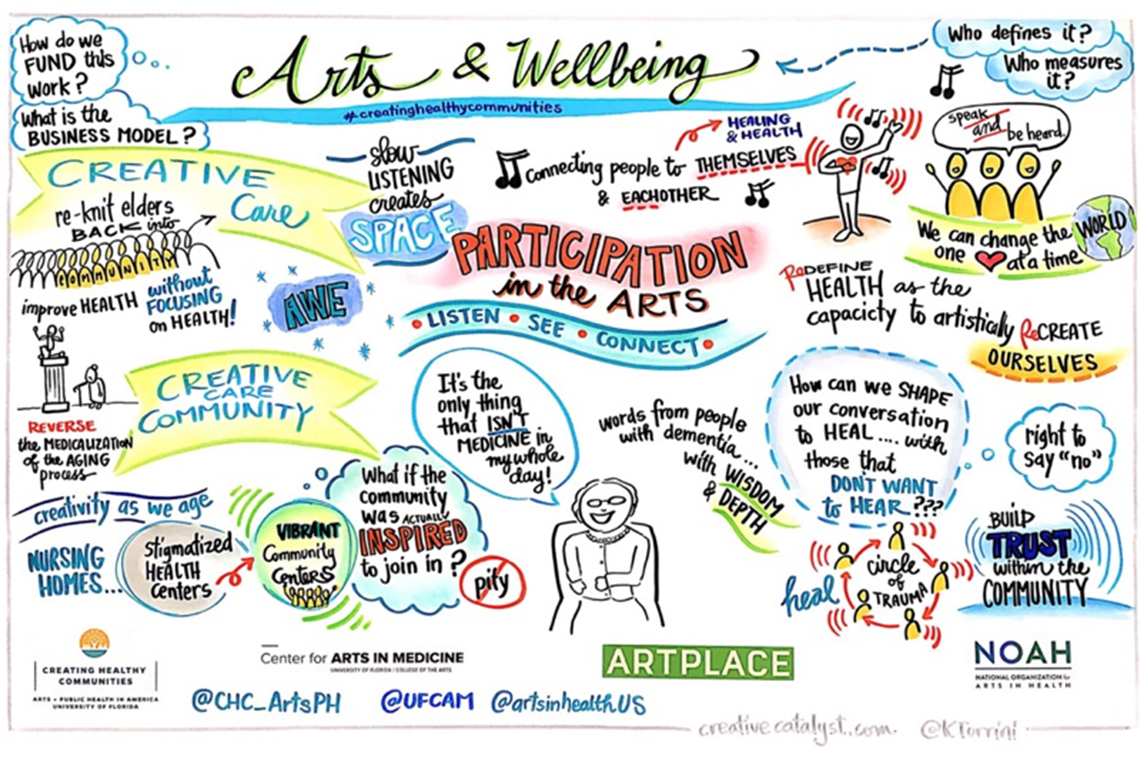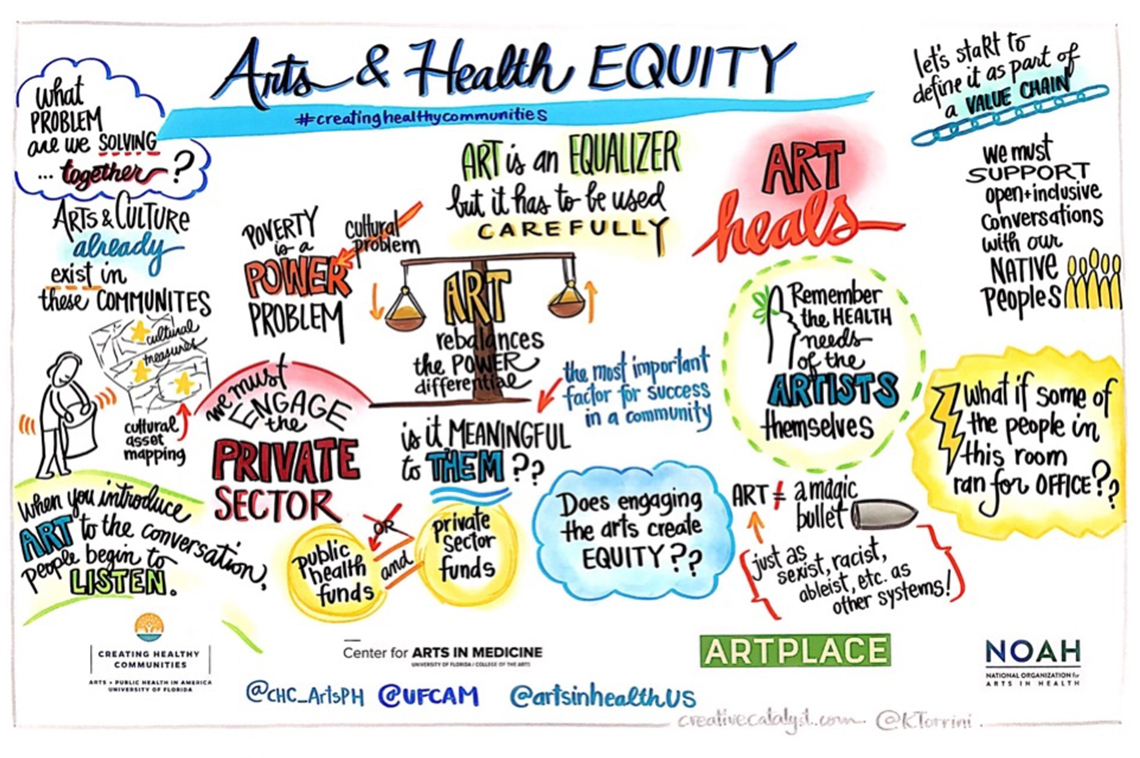



Before Kelley Sams joined the University of Florida’s Creating Healthy Communities: Arts + Public Health in America initiative, housed in the university’s Center for Arts in Medicine, she earned a fine arts degree and served with the Peace Corps as a health volunteer in Niger.
“I got really into media like billboards and flip charts that were being used to promote healthy habits like hand-washing and sleeping under mosquito nets,” she says. “Because of low levels of literacy, artists were engaged to communicate these messages in visual language. That got me interested in health communications through the arts. Visual art, as well as music and drama, are a big part of doing public health work there. We do it here, too, but it’s not as systematically integrated.”
Fast forward a couple of decades, and Sams is the visiting research scholar for Creating Healthy Communities, a two-year national initiative launched in May 2018 with support from ArtPlace America to accelerate innovation at the intersections of the arts, creative placemaking, community development, and public health through cross-sector collaboration, discovery, translation, and dissemination.
“ArtPlace wanted our partner for this health work to be an academic institution—something we’d never done before,” says Jamie Hand, director of research strategies for ArtPlace. “We realized we needed to be able to get this work in front of medical audiences and publish it in academic journals. The health field is so broad, yet it uses a very specific, evidence-based approach. We knew the University of Florida Center for Arts in Medicine would be the perfect partner to help us navigate these challenges and make the right connections to propel this important work forward.”
Why this Initiative—and How Does it Work?
“Many healthcare facilities in the United States now have artists in residence, and are recognizing the importance of the arts to good patient care,” Sams says. “But, arts and public health hasn’t experienced the same kind of recognition as the more clinical side has—even though there are many people out there doing the work.”
Through the development of a national consortium and a series of working group convenings (the next one is in Washington, DC, this week), Creating Healthy Communities is connecting the people and programs already tackling this work—many in silos—to build a stronger, more cohesive network across the arts and culture, public health, community development, creative placemaking, and healthcare fields. The sharing of knowledge, best practices, and effective research strategies is at the heart of the initiative.
“The way I see it is that this initiative is designed to be a pebble thrown into the water that will produce ripples that go way beyond us,” Sams says.
Creating Healthy Communities is also using discovery and translation processes—including a field survey, focus groups, and scoping review—that will help them map, assess, and consolidate existing evidence, and eventually help establish a national research agenda, standardized protocols, and an evidence-based framework for using the arts in public health.
Sams has been leading the scoping review. “It’s been interesting to note what’s being published about a lot in academic journals and what’s not so much,” she says. For example, she’s found that few journals have run stories about public art projects like murals that center public health themes. By contrast, she says, “academics have really embraced photovoice,” a documentary method in which participants take photographs to illustrate situations in their lives.
“We want to engage policy-makers and others who speak this academic language, as well as those who share what they do, in different ways,” Sams says. “We want to make the point that journals have every reason to publish about all the different kinds of art-based methods being employed in public health today.”
A Rich History
The University of Florida Center for Arts in Medicine was founded in 1996 to further the field of arts in health by advancing interdisciplinary research, education, and practice, both locally and globally. The Center works to connect students, faculty, healthcare providers, and local communities, and offers a variety of training programs, degrees, and certificates.
In the past 20-plus years, the Center has been a party to many high-profile arts-based solutions to public health challenges. For example, Jill Sonke, the Center’s director, published an article in 2015 called “The arts and health messaging: Exploring the evidence and lessons from the 2014 Ebola outbreak.” Among other case studies, she presented this memorable one, which was also publicized by NPR:
“Early in the [Ebola] crisis, grassroots efforts by local artists emerged. One of the earliest responses was the song Ebola in Town, written and produced by Liberian rap artists, Shadow and D12, in May of 2014. Within three days of its internet release, the song was playing on Liberian radio stations and in dance clubs, and soon topped the local charts. While the lyrics were improvised by the artists and not informed by health professionals, the song demonstrated the power of popular music to convey Ebola messages and paved the way for the release of dozens of other songs and music videos created through collaborations between artists and health professionals to deliver more targeted messages.”
“These efforts and many others have attracted widespread attention and enthusiasm, both locally and abroad, reaching massive audiences more quickly and efficiently than standard health messaging approaches. While the general public often views health professionals with distrust, such as has been demonstrated in Ebola-affected areas, artists are generally viewed as peers and non-threatening to community members. They are also available resources in affected areas, and have a unique understanding of local cultures and expertise in human engagement. Recent studies in the affected regions have shown that even under extreme conditions, communities can rapidly internalize positive health messages, abandon negative health messages, and refine known health messages through social learning constructs.”
Working for the Big Picture
To sum it all up, Sams offers this connection: “Art and health are both so important to the human experience. That’s why this is such a good fit. Health is about more than washing your hands to avoid disease: it’s about being able to live your fullest life and explore all the possibilities. That’s exactly what art is about, too.”
More information
- Sign up for the Creating Healthy Communities online network to joining the growing national conversation about the arts, public health, and community building in America.
- The initiative’s fifth working group is taking place this week, January 17 & 18, in Washington, DC. Participants will be live tweeting from the event.
- Complete the 23-question field survey to help Creating Healthy Communities capture some of the work taking place at the intersections of the arts, public health, and community building in the U.S. today—and share it with your colleagues!
- Explore other groups working at the intersection of arts and health, including the National Organization for Arts in Health, and Americans for the Arts’ New Community Visions Initiative.





